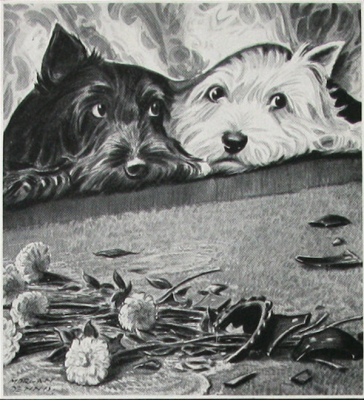
Scottish Terriers were iconic images in advertising for a very long time, and they were typically depicted as a pair: One black one, and one white one. The James Buchanan Company, in particular, used “Blackie” and “Whitey” in its branding for Black & White Scotch Whisky, an idea conceived by James Buchanan himself during the 1890s, and later rendered into images created by Morgan Dennis. There was just one detail that an inattentive public usually didn’t grasp (or care about): “Blackie” and “Whitie” were not two Scotties, but one black Scottish Terrier and a West Highland White Terrier. A snow white Scottie is incorrect and unknown, but the notion that the breed comes in this color remains a part of the public’s knowledge base of the breed (the ignorant part), and it probably has its roots in those old ads.
Scotties do come in colors other than black, and the first English Standard in 1887 identified a variety of shades: “Steel or iron  grey, black brindle, brown brindle, grey brindle, black, sandy and wheaten.” The other Scottie colors are “brindle” and “wheaten,” a recessive gene.
grey, black brindle, brown brindle, grey brindle, black, sandy and wheaten.” The other Scottie colors are “brindle” and “wheaten,” a recessive gene.
Some wheaten Scotties are very light in color, and sometimes they can even be mistaken for being white (perhaps another reason why some folks believe the Scottie can be white), but the breed’s official standard writes that white markings are permissible “only on the chest and chin and that to a slight extent only.” Black, however, is the most prevalent color. Roughly 600 owners participated in a 2005 survey done by the Scottish Terrier Club of America, and of them, 66.4% had black dogs, 21.5% had brindles, and only 11.1% had wheaten colored Scotties (1% didn’t list a color).
The genetics of the color are interesting (but genetics is wading into tall grass for us, probably because it’s too close to math, and we don’t do math, so we welcome the input of those of you whom we know to love this stuff). As far as we know, if wheaten mom has black puppies, the sire will be black but without the wheaten gene (and the pups inherit the wheaten gene from mom). For a mom to have wheaten pups, she’d have to mate with a wheaten male (and 50% of the pups should be wheaten) or with a black dog that has the wheaten gene (and then 25% of the litter should be wheaten). When wheaten to wheaten is bred, we get 100% wheaten pups.
It’s important to know that in evaluating the breed, no color is preferred over another. A Scottie should have a double coat that protects his or her body as they do their job: Exterminate vermin! A soft, dense undercoat and a hard, wiry, weather-resistant textured top coat should trump color every time.

Very often the “white” Scottie is really a West Highland White Terrier. A close relative, but definitely NOT a Scottie.
Agreed! We said as much in the article (we think?)
My favorite color (pattern) in Scotties is brindle.
An awesome color, Linda, we agree, and one that seems to be getting harder to find!
For those genetics enthusiasts, here are coat colours galore, love this web site.
http://doggenetics.co.uk
Fabulous site, Holly, one we’ve admired for ages. One day, we’ll understand most of it (grin). Thanks for sharing it!